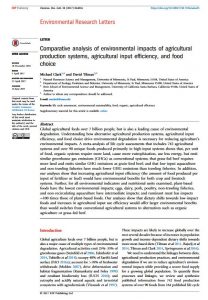Global agriculture feeds over 7 billion people but is also a leading cause of environmental degradation. Understanding how alternative agricultural production systems, agricultural input efficiency and food choice drive environmental degradation is necessary for reducing agriculture’s environmental impacts. A meta-analysis of life cycle assessments that includes 742 agricultural systems and over 90 unique foods produced primarily in high-input systems shows that, per unit of food, organic systems require more land, cause more eutrophication, use less energy, but emit similar greenhouse gas emissions (GHGs) as conventional systems; that grass-fed beef requires more land and emits similar GHG emissions as grain-feed beef; and that low-input aquaculture and non-trawling fisheries have much lower GHG emissions than trawling fisheries. In addition, our analyses show that increasing agricultural input efficiency (the amount of food produced per input of fertiliser or feed) would have environmental benefits for both crop and livestock systems. Further, for all environmental indicators and nutritional units examined, plant-based foods have the lowest environmental impacts; eggs, dairy, pork, poultry, non-trawling fisheries, and non-recirculating aquaculture have intermediate impacts; and ruminant meat has impacts ~100 times those of plant-based foods. Our analyses show that dietary shifts towards low-impact foods and increases in agricultural input use efficiency would offer larger environmental benefits than would switches from conventional agricultural systems to alternatives such as organic agriculture or grass-fed beef.
Region: Not specific
Date published:
2017
Published by:
IOP Publishing
Type of resource:
Journal article
Resource topic:
Climate change
Project/Programme: Not specific
Pest/Disease: Not specific
Pages:
12
File type:
External link (1,349 KB)




